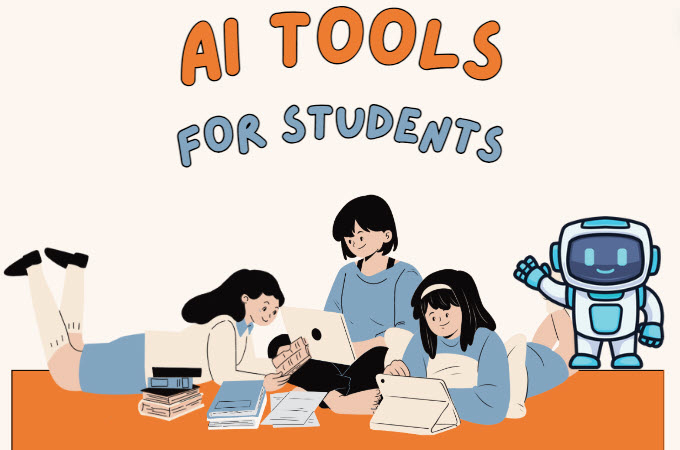
Studying effectively in 2024 involves leveraging the best AI tools tailored to your academic needs. Whether it’s composing essays, grasping new languages, or mastering complex concepts, AI can offer personalized assistance that adapts to your learning style. This article demystifies AI tools for students, presenting top picks that promise to enhance your educational experience by making it engaging, efficient, and highly individualized.
Key Takeaways
- Artificial Intelligence changes education by providing customized learning and supporting students with diverse needs, such as disabilities and language differences, and by continuously monitoring their progress.
- AI tools for learning help students in different ways, like with writing, learning languages, and adjusting to how they learn. These tools make learning easier, help them understand better, and improve the quality of their education.
- Choosing the best AI tools involves ensuring compatibility with your school setup, their effectiveness in facilitating learning, reliability, and understanding what AI can and cannot do.
The Power of AI in Education

Artificial Intelligence is not just about robots and high-tech devices; it’s about creating a new world of learning possibilities. Imagine a world where each student receives personalized instruction, tailored to their unique needs, behavior patterns, and learning pace in real-time. This is the power of AI tools for education – it transforms the conventional one-size-fits-all approach to education, creating a personalized learning landscape.
AI in education has the potential to:
- Support students with disabilities
- Cater to multilingual learners
- Provide real-time feedback and assessment
- Identify gaps in knowledge and provide targeted interventions
- Enhance teacher effectiveness and efficiency
- Improve student engagement and motivation
With AI, education can become more inclusive and adaptable, ensuring that every student has the opportunity to thrive and succeed.
AI doesn’t stop at customizing learning; it’s changing the way students and educators interact and evolve. It provides continuous feedback, thus offering opportunities for constant improvement. Moreover, AI enables new forms of interaction in education, incorporating natural communication methods like speech and gesture, thus fostering inclusivity. Imagine a student struggling with a complex calculus problem at midnight. Now, picture a virtual tutor powered by AI, assisting that student, turning their struggle into understanding. That’s the potential of AI in education.
Essential AI Tool Categories for Students
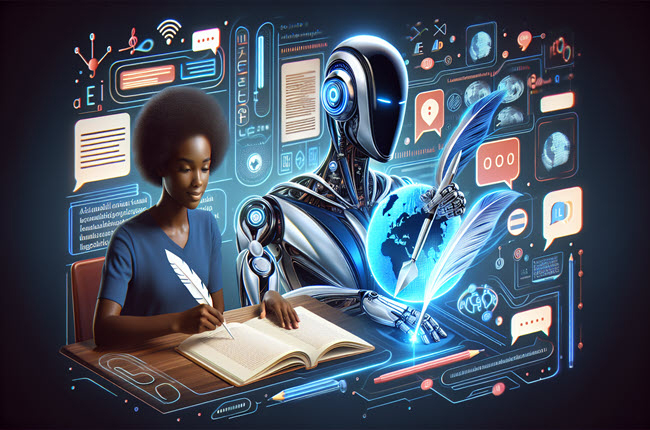
As we delve deeper into the role of AI in education, it’s crucial to understand the key categories of AI tools that students can leverage. The AI tools for homework are designed with one aim – to enhance the learning experience by providing personalized support tailored to individual needs. Learning platforms like Docebo are a testament to this, offering a suite of AI-powered features that facilitate efficient information retrieval, content organization, and collaborative learning.
Three categories of AI tools are particularly transformative for students: AI-powered writing assistants, language learning platforms, and adaptive learning systems. Each of these categories offers unique functionalities, collectively contributing to a well-rounded, engaging, and personalized learning experience with the help of AI powered tools.
AI-Powered Writing Assistants
Have you ever struggled to find the right words? Or spent hours proofreading an essay? The AI powered writing assistant is here to help. They aid students in crafting compelling copy, expediting the publishing process, and enhancing overall writing quality in the realm of academic research, including research papers.
AI tools for students like Grammarly are a boon for students, providing real-time feedback to correct:
- grammar
- spelling
- punctuation
- stylistic errors
But how do they do it? Most AI writing assistants leverage large language models like GPT-3 or GPT-4 to produce text based on user prompts. However, the effectiveness of AI writing tools in assisting students depends on human oversight and the breadth and quality of their training data. So, while the tool can provide instant feedback and suggestions, it’s still up to the student to make the final edits, making AI a partner in the writing process rather than a replacement.
Language Learning Platforms
It can be hard to learn a new language, but AI programs especially AI tools for learning are making it easier and more fun. AI tools in language learning apps help you speak better, feel more sure of yourself, and quickly get answers to your questions. This is really important for learning a language well. These apps use special technology to understand what you say and reply to you, which makes learning more like talking to a real person and tailored to you.
For instance, Knowji’s AI-driven language learning app incorporates:
- Cognitive science
- Pedagogical principles
- Personalized lessons
- Latest educational technology
These features offer personalized learning resources in the form of personalized lessons anchored in the latest educational technology.
Quillbot contributes to language learning with a translator tool that supports over 30 languages, aiding users in translating texts and improving their language comprehension skills. So, whether you’re a Spanish student trying to understand Don Quixote in its original form, or a business student translating global market research, AI-powered language learning platforms have got you covered.
Adaptive Learning Systems
Adaptive learning systems are the third category of AI tools for education that are transforming education. These systems provide a customized learning experience for each student, adjusting the content based on individual performance and needs, thanks to machine learning algorithms. For instance, Smart Sparrow incorporates advanced adaptive techniques to fine-tune educational content and paths for individual student requirements.
Another brilliant example is Tutor.ai, which provides personalized assistance through virtual tutoring, enabling students to have a more focused and supportive learning experience tailored to their knowledge gaps and learning speed. Imagine a tutor who understands your strengths, works on your weaknesses, and is available round the clock – that’s the power of AI in adaptive learning systems.
Top 10 AI Tools for Students in 2024

Now that we’ve explored the categories of AI tools, let’s dive into the top AI tools that are reshaping the educational landscape for students in 2024. These tools, ranging from AI-powered writing assistants to language learning platforms and adaptive learning systems, each offer unique features to support diverse academic needs. Whether you’re a literature student drafting an essay, a business student organizing a project, or a language student practicing new vocabulary, there’s an AI tools for homework to assist you.
While this list is not exhaustive, it provides a snapshot of the rich diversity of AI tools available today, each with its unique features and strengths. These tools illustrate how AI is not only enhancing the way students learn but also transforming the way they engage with the learning process, making it more interactive, personalized, and efficient.
RecCloud
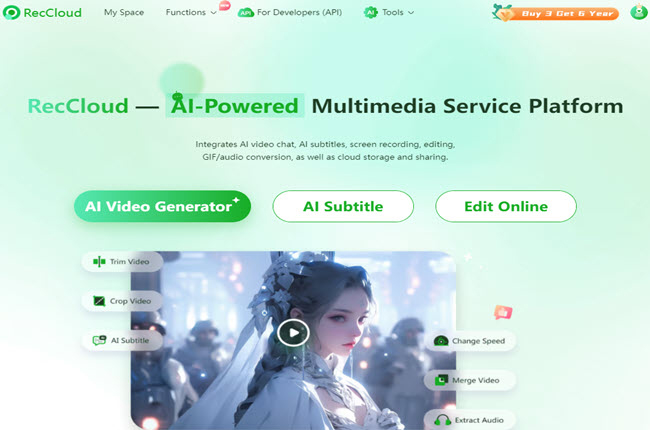
If you’re a student seeking a program to simplify complex tasks into easy steps, the first tool to consider is RecCloud. This multi-purpose program can easily fulfill your daily academic requirements as a student. Here are some of its features explaining why this program is considered one of the best AI tools for students:
- Enables users to get a summary from long audio and video content like seminars, discussions, meetings and many more.
- Turn text into speech instantly.
- Precise audio to text transcription.
- Provides a chatbot that you can query regarding the file you’ve uploaded to its website.
- Generate captions for your video content right away.
- Translate videos to other languages.
Furthermore, this online tool also gives you other ways to edit your videos and make them better, such as:
- AI Video Generator
- Change Video Speed
- Merge Video
- Video to GIF Converter
- Crop Video
Overall, this tool is one of the best programs you can rely on if you’re a student looking to manage lengthy audio and video files for your studies.
ClickUp
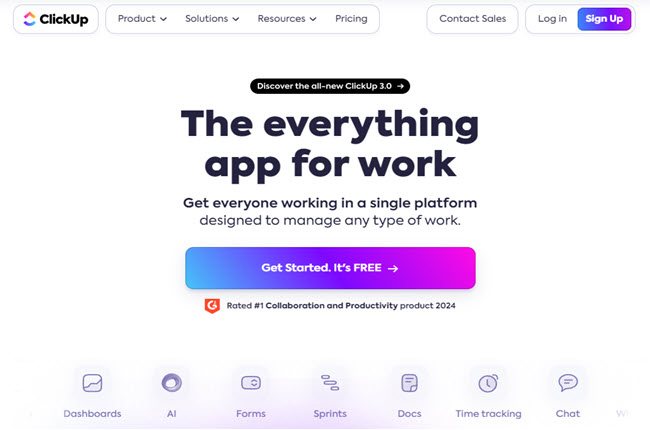
Second on our list is ClickUp, an AI tool for learning that supports students in organizing and executing academic tasks more effectively.The platform helps students by:
- Breaking down assignments into manageable steps
- Prioritizing tasks based on urgency
- Including collaborative tools for real-time editing and commenting
- Facilitating group assignments with a chat function
Moreover, ClickUp provides the following features to help students improve their productivity and optimize their study routines:
- Productivity analysis to suggest improvements
- Task management for juggling multiple assignments
- Collaboration tools for group projects
- Study routine optimization
So whether you’re juggling multiple assignments, collaborating on a group project, or trying to optimize your study routine, ClickUp can be your trusted ally.
Gradescope
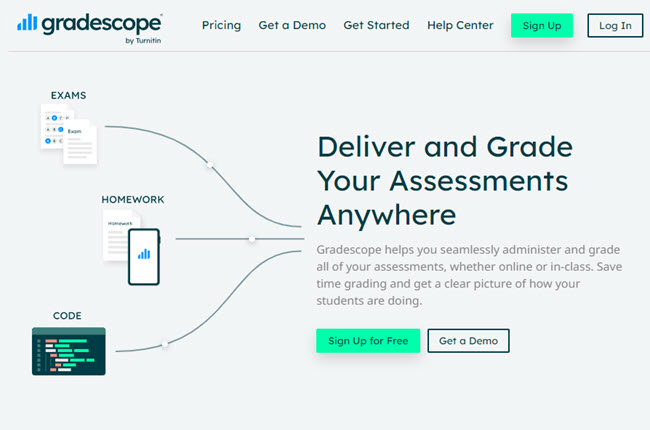
Gradescope, an AI-powered grading tool, enhances the efficiency of the grading process by allowing online submission of assignments and automating grading for various question types, including multiple-choice, fill-in-the-blank, and coding questions. With this AI tools for education, teachers can provide more timely and detailed feedback, while students can receive a better understanding of their performance.
This tool offers the following benefits:
- Reduces the time and effort required for grading
- Provides valuable insights into student understanding and performance
- Helps identify common misconceptions and gaps in understanding
- Enables more targeted and effective teaching strategies
Otter.ai
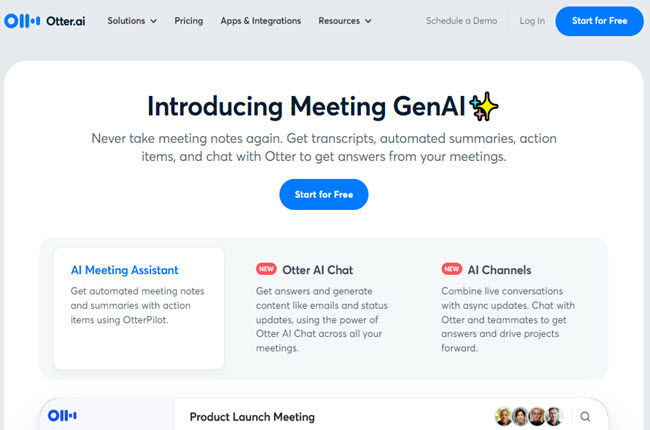
Moving on to Otter.ai, this cutting-edge tool offers a transcription service that is powered by AI. Otter.ai’s features include:
- Real-time transcription
- High accuracy
- Speaker identification
- Time stamps
It can transcribe meetings, including audio from Zoom and Google Meet, with these advanced capabilities.
Imagine attending a lecture and having to jot down notes while trying to keep up with the professor’s pace. Now, picture Otter.ai attending the lecture on your behalf and providing you with a comprehensive, timestamped transcript that you can review at your convenience – sounds like a dream, right? Well, that’s the power of AI tools for homework.
Knowji
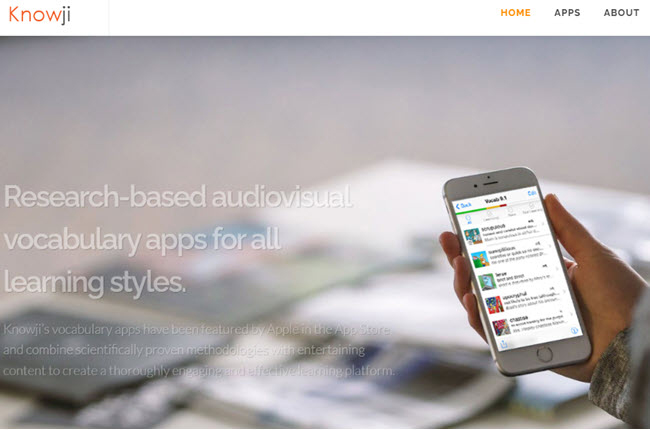
Next on our list is Knowji, a language app that offers the following features:
- Utilizes cutting-edge AI combined with cognitive science principles
- Creates a unique educational experience
- Uses spaced repetition and other cognitive strategies to enhance vocabulary retention
Knowji offers special vocabulary lessons that change based on how fast you learn. It has fun activities and quizzes to help you understand and use words better. Knowji also keeps track of how you’re doing and reminds you to keep going, so learning a language feels fun and makes you feel good when you do well.
OpenAI
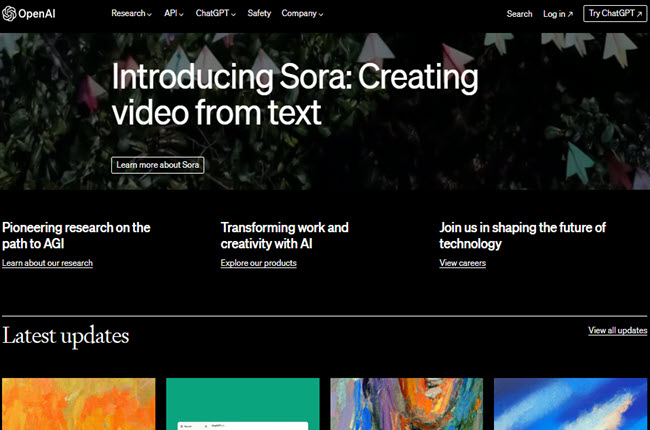
OpenAI is another standout AI tools for students that assists in drafting, editing, and brainstorming, thereby enhancing students’ writing and research capabilities. Whether you’re a literature student brainstorming for a story or a computer science student drafting a research paper, OpenAI’s language models can be a valuable resource among free ai tools.
The power of OpenAI lies in its ability to generate text based on user prompts, making it a versatile tool for a variety of writing tasks. Here are some examples of how OpenAI can be used:
- Drafting essays
- Jotting down meeting minutes
- Creating blog posts
- Writing product descriptions
- Generating social media captions
OpenAI, an AI powered writing tool, is revolutionizing the way students approach writing and is a valuable tool for anyone looking to improve their writing productivity.
Wolfram Alpha
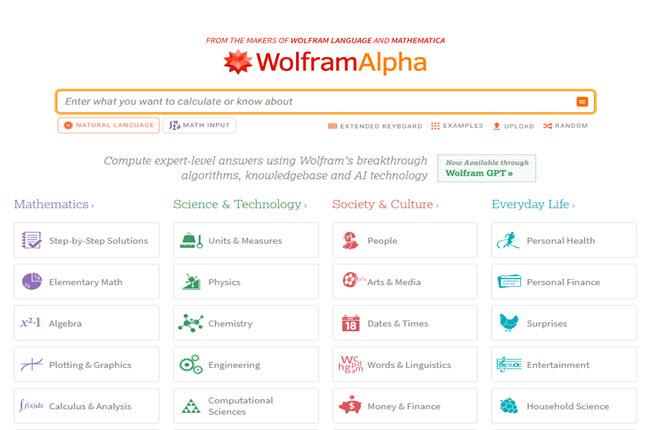
Last but not least is Wolfram Alpha, an AI tools for homework that offers a range of features specifically for students, including:
- Homework assistance
- Research capabilities
- Customized visuals generation
- Data analysis with the ability to upload their own data
Students can utilize Wolfram Alpha Pro to take advantage of these features.
The platform provides step-by-step solutions to equations and problems, acting as an automated tutor for students. Whether you’re a math student trying to solve a complex equation or a statistics student analyzing data, Wolfram Alpha simplifies your academic journey, making it a must-have tool in today’s digital learning environment.
Audiopen.ai
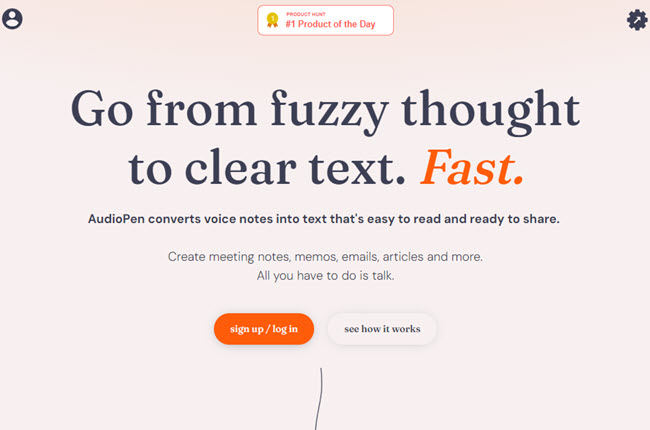
Picture turning your spoken words into polished text ready to share. That’s what Audiopen.ai, a tool for students, does. It helps students work faster by letting them write papers, memos, and emails much quicker than usual.
If you prefer speaking to typing or are always busy, Audiopen.ai can be a great help. This one of the leading AI tools for students lets you record your thoughts wherever you are and turns them into organized writing.
Smart Sparrow

Next up is Smart Sparrow, a tool that utilizes specialized learning paths and engaging activities like virtual labs. It focuses on active learning, which means you get to use what you learn in real life.
If you’re studying biology and doing a virtual dissection or learning physics by simulating motion, Smart Sparrow makes it feel like you’re really there. It also helps you work with others on projects and share ideas, which helps you think better.
Quillbot

Next up is Quillbot, a comprehensive AI tool for learning that supports diverse academic writing needs. Quillbot enhances its offerings with unlimited paraphrase length, faster processing, and added insights on tone, plagiarism, and text complexity to refine students’ content. It addresses different writing challenges and styles with its various paraphrasing modes like Standard, Formal, and Creative.
The platform also integrates seamlessly with Microsoft Word and offers a native macOS application, ensuring user-friendly access across multiple writing platforms. With Quillbot, students can organically improve their writing skills and internalize better writing habits, thereby contributing to improved writing quality and academic performance.
Choosing the Right AI Tool for Your Needs
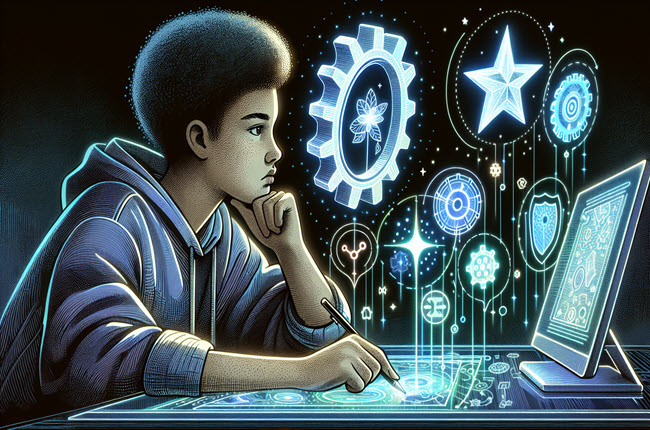
There are many AI tools for students, and they can perform amazing tasks. But not all tools are the same. Picking the right one means thinking about things like if it works with your school stuff, if it actually helps you, and knowing what AI can’t do in education.
Keep in mind that AI tools for education are meant to enhance traditional teaching methods, not replace them. When you use AI tools with your teaching, they’re supposed to make learning more fun, easier, and tailored just for you. But the main aim should always be to help you really get into learning and enjoy it.
The Future of AI in Education

As we look to the future, the role of AI in education is set to become even more significant. Some ways in which AI is revolutionizing the way students interact with traditional classroom models include:
- Micro-credentialing and modular content that tailor to the individual goals and preferences of students
- Immersive AI-driven experiences like virtual labs
- Round-the-clock tutoring
AI is transforming education and providing students with personalized and innovative learning experiences.
Moreover, AI’s data analytics are key in improving student learning results by providing insights that help in optimizing curricula and teaching methods. As AI tools for homework becomes more integrated into the education sector, the learning landscape will continue to evolve, promising a future of education that is more personalized, engaging, and inclusive.
Preparing for a Career in AI
After exploring AI in education, you might wonder how to prepare for a career in this exciting field. Start by understanding AI, machine learning, and Python. Then, look into different ways to learn about them and the jobs you can do in tech.
In the AI field, there are lots of jobs for students who like tech. Whether you want to make the next big AI thing or use AI in areas like healthcare or finance, start by learning about AI. That’s the first step to getting into this exciting world.
Conclusion
In conclusion, the landscape of education is undergoing a transformation, fueled by AI. From personalized learning experiences to enhanced accessibility and improved student engagement, AI is reshaping the way students learn and interact with education. As we continue to embrace these changes, it’s clear that the future of education is bright, promising a world of learning that is more engaging, efficient, and inclusive than ever before. Among these AI tools for students, we personally recommend RecCloud because of its flexible features perfect for students.
Frequently Asked Questions
How can you use AI as a student?
You can use AI tools as a student to engage in interactive learning through platforms like chatbots and virtual tutors, as well as to analyze and adapt to your learning patterns based on data-driven insights. This can enhance your understanding of complex topics and improve retention.
Is there a free AI I can use?
Yes, there are free AI tools available for use. Some popular options include Stable Diffusion for generating images from text prompts, Canva’s AI Art Generator for creating designs, and Google Cloud’s AI products like Translation and Speech-to-Text, which have free usage up to monthly limits.
How are AI tools used in education?
AI tools in education are used to gauge students’ learning styles and pre-existing knowledge, delivering customized support and instruction. They can also compile data about student performance and grade more abstract assessments such as essays.
What is the best AI for students?
The best AI for students is an integrated tool with Word or your browser, as well as a standalone app, making it a top choice for its versatility and ease of use. Consider integrating it into your study routine.
What are some AI tools that students can use?
Students can use AI tools such as Grammarly for writing assistance, Knowji for language learning, and Smart Sparrow for adaptive learning. These tools can significantly enhance their academic experience and efficiency.
Leave a Comment